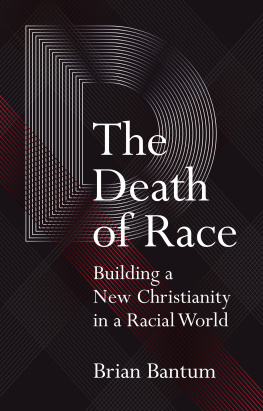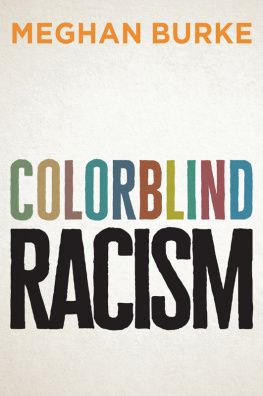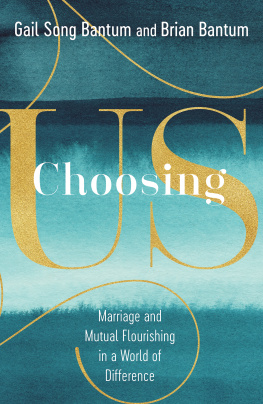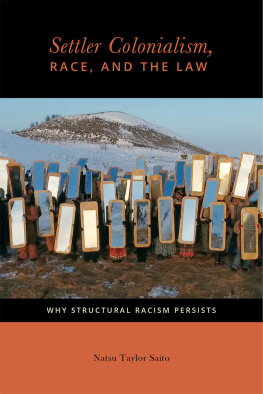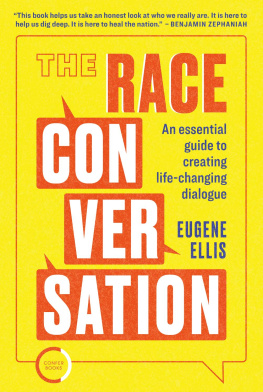The Death of Race
Building a New Christianity in a Racial World
Brian Bantum
Fortress Press
Minneapolis
THE DEATH OF RACE
Building a New Christianity in a Racial World
Copyright 2016 Fortress Press. All rights reserved. Except for brief quotations in critical articles or reviews, no part of this book may be reproduced in any manner without prior written permission from the publisher.
Visit http://www.augsburgfortress.org/copyrights/ or write to Permissions, Augsburg Fortress, Box 1209, Minneapolis, MN 55440.
Cover design: Brad Norr
Library of Congress Cataloging-in-Publication Data
Print ISBN: 978-1-5064-0888-0
eBook ISBN: 978-1-5064-0889-7
The paper used in this publication meets the minimum requirements of American National Standard for Information Sciences Permanence of Paper for Printed Library Materials, ANSI Z329.48-1984.
Manufactured in the U.S.A.
This book was produced using Pressbooks.com.
To Caleb, Ezra, and Joseph
Because your bodies hold many stories.
Because your bodies are bearers of God.
Contents
Every summer, after classes have ended and before I begin any writing projects, I build something. It has become something of a yearly ritual. I put my books away, leave the computer off, and pull my tools from the corner of the garage where theyve been sitting for eleven months. Its usually a bookshelf, or a cabinet. At first I was just a poor grad student who needed someplace to put books and papers.
The feeling of wood going smooth, after a few passes with the sander, a pile of wood becoming structure and purpose, the smell of my work sticking to my clothes and hair when I was done for the daythere was something grounded about this work after a year of working with words and ideas. Building was a balm, a sign that I could touch and see, reminding me throughout the year that small steps accumulate, that it is possible to go from ideas into something that was real.
But with every summer I had to start again. I didnt build the same set of bookshelves again and again. It was a twelve-foot-high, floor-to-ceiling bookcase one year, a built-in media cabinet another. Each summer was a new space in the house, a new set of problems and skills unique to that project. I am a novice builder, so I did the best I could and learned from my mistakes.
Having built something myself, my eye was drawn again and again to true craftsmanship. A set of library shelves, or a table with beveled edges, or a chair that fit your back just right. Great carpenters build for the space, for what is needed in that house in that corner. They dont make the same shelf for every job.
The last four summers have begun with the familiar drone of sanders and saws. But these projects were also followed, almost liturgically, with outrage and lament as our family watched the succession of black men and women killed by police. Wed follow the news and seemingly inevitable nonindictments. July and August would be cycles of well-worn tropes of black on black crime and white guilt then backlash, and another murder and another exoneration. And then fall came with a new academic year.
I would return to teaching, and to welcome students to the task and beauty of theology. Early in my teaching it took time for students to see the significance of race, of gender, of the ways bodies had been so violently divided. But now they returned not needing to be convinced. And they wanted theology to matter. The theologies that had been built for them did not fit the space they now lived in. They had questions. What they witnessed over those summers, what they had seen (or not seen) in their congregations seemed inadequate. For others, especially my students of color, they returned to campus with grief and anger that their theologies could not name.
They did not lack desire or commitment. What I found in my conversations with them was that, at its heart, their Christianity rarely accounted for their bodies, their difference. Race, gender, sexuality, differing abilities. These everyday realities of their lives rarely intersected with conversations about Jesus and salvation, or even what it means to be human.
Initially, I did not want to write this book, yet another book on race. There are pastors, activists, and scholars whose voices are speaking to policies, theories, theologies, and histories in powerful ways. But the more time I have spent with my students, the more I have come to believe that we need to build something new, something that speaks to our moment, that can faithfully narrate Christianity in a racial world, but also account for gender, for the differences inherent in our bodies. This book is not about how to build a new Christianity. This book is an offering, a prayer. It is the sketch of a new shelf that might fit our space, our moment. I am not building from nothing. I am breaking boards and prying out old nails, cutting and sanding from the shelves and chairs and tables of saints that have walked before. But I am building for now, for my children, my students, for myself. It is a theology written as if our bodies matteredmattered in our very creation, in our fall, in our redemption, and in our following. It is a starting point for people who want to tell a new story about their God, their bodies and lives together.
This book is clearer and richer because of Amey Victoria Adkins and Sarah Keough, who offered insightful critique and questions. This book would not have been possible without the support of Seattle Pacific University, which granted me a sabbatical to write and sit with this text. My friend and colleague, Jeff Keuss, exemplifies what it means to create space for others and imagine an ever-widening community of faithful witnesses. My editor, Lisa Gruenisen, continued to press for the book she knew I could write when I wanted to settle. Above all, this book bears the indelible wisdom of my wife, Pastor Gail Song Bantum, whose question continued to guide and afflict me as I wrote. Who is this book for? she said. Prayerfully, I am writing for my people, and whoever feels the call to walk with us on the way.
1
Race Is a Story Written on My Body
You have to choose. Pick a box, white or black, my mother told me in the lobby of the bank, the blank social security form laid out on the glass table. It doesnt really mean anything. Its just a government form, but you can only choose one, she said. But, for a six-year-old everything has meaning. So I considered my mom and dad. I considered myself, lighter skin than my brother and father, straight auburn hair like my mother. To be real, I liked her better. White, I said after these quick calculations. But of course it didnt have any meaning. Black, my brother chose after doing his own internal math. This was the first moment I began to tell the story of my body, when I began to feel that my body was a story.
My mother wanted to believe that my decision didnt have any meaning. But of course it did. The story took shape in small ways at first, ways that I didnt intend. Somehow I found myself in its pages. I would read its words. The words of race would read me.
Why you talk like that? We were all hanging on monkey bars during recess.
Me? Talk like what? I talk like my mom and dad. Why do you talk like that? I saw a me instead of an us.
There were innocent middle school crushes and a few notes from girls whose skin was like mine, brown eyes, brown hair. They saw me as I walked through the halls, looked at me in ways the little white girls didnt. Were they like me? Was I like them? Im ashamed to admit it, but I didnt think so at the time. Like most kids that try to navigate the purgatory of middle school, I tried to say who I was by being sure of what I wasnt. This is how we all come to understand who we aredrawing lines of similarity and distinction, conjuring an image of ourselves and doing our best to live into that image or resist it.

